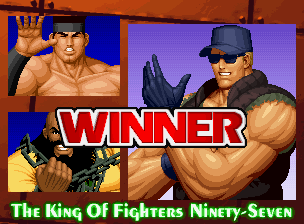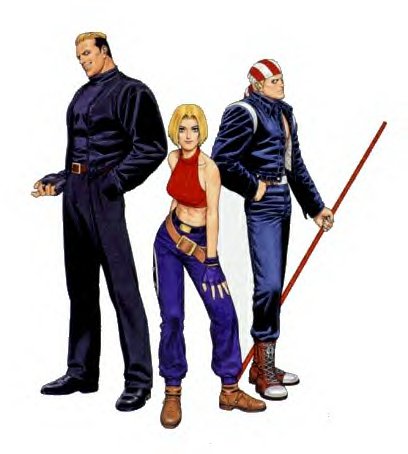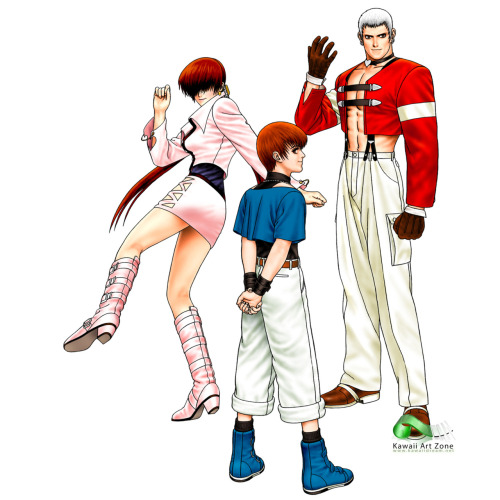Despite the supernatural stadium demolition and villain intervention in 1996’s KOF tournament, it was a massive success, with the events of the finale blamed on terrorist activity.
Yeah. Terrorists with whirlwind powers and only a single member. I imagine that'd be a pretty tough one to explain. Why are terrorists so often scapegoats for supernatural destruction?
Chizuru officially participates in the '97 tournament, replacing Kasumi Todoh on the women’s fighting team. The heroes of the last game must’ve beaten her to the point of crippling though, because she has less health and does less damage. That's not the last time we'll see Chizuru crippled.
Along with Kasumi and Iori’s female partners, the boss team
is also absent this year. Instead, Geese
Howard has hired his own team of Fatal Fury mercenaries to infiltrate the tournament: 95’s returning staff twirler Billy Kane, grappling
girl Blue Mary, and resident psychopath Ryuji Yamazaki.
Geese hired Billy to keep an eye on Iori Yagami, who displayed an interesting power at the end of the '96 tournament. Blue Mary, meanwhile, is assigned to keep an eye on Ryuji (who has been promised double the prize money if they win), but her employer is a fake company owned by Geese, only using her to have her on his team.
New to SNK as a whole is the mysterious and fittingly-named
New Faces team, comprised of the three dance battlers Chris, Yashiro, and
Shermie. All three of them make up their
own rock band, and entered the ’97 tournament (after fighting the American sports team for their invitations) to show up Iori, who
showed them up on a gig originally
planned for them.
Well, they already showed him up just by entering, since
Iori doesn’t have an official team this year, after… Disagreements with his last two
teammates (he does not have the best
luck making friends). Ioro's still an entrant in '97, just a "seeded" competitor.
All three members of the New Faces team have methodical, swaying moves much like a dance. Yashiro, the big guy, wrecks with his fists, Shermie, the girl, grapples and spins, and Chris, the kid, is fast and hard to predict.
All three members of the New Faces team have methodical, swaying moves much like a dance. Yashiro, the big guy, wrecks with his fists, Shermie, the girl, grapples and spins, and Chris, the kid, is fast and hard to predict.
Also teamless is new character Shingo Yabuki, a high school
kid who idolizes and imitates Kyo and his fighting style even though he can't shoot flames (don't tell him that though).
 |
| おれのかちだ! |
Shingo is essentially a comic relief badass. He's a classmate of Kyo's, who has showed Shingo some of his moves at school in exchange for lunches. For hours Shingo practiced his moves on the tree Kyo and he met under until he was offered a place in the KOF '97 tournament. When it comes time to throw down, Shingo does imitations of Kyo’s moves, often clumsily
executes them, but always remains optimistic and confident.
For reference, his antics throughout the series include
constantly checking his notebook (including in the middle of performing an
attack), singing his own victory songs, and accidentally falling on his opponent
mid-attack. In one game, he can even
assist your team by tripping and grabbing an opponent by their heels whilst
kicking his legs in an undignified fashion.
But Shingo hits hard. He’s the only character in
the series who can land critical hits, and with his well-rounded moveset, he’s
a deadly force in the right hands. Get
used to him, because he sticks around for quite a while after ’97.
 |
| ビシ! バシ! ドカン!(Onomatopoeia) |
King of Fighters 97 has a unique aesthetic from the other games in the series. It really sells you on the fact that KOF is
a televised sporting event through its details in the transitions and stages. The stages show several camera crews, massive
crowds, security personnel barring off the arenas, girls holding up signs to
show what round it is, and giant KOF logos in the middle of each floor.
The transitions are simple and short, but flashy. They display information on the next stage before focusing on it. As an extra touch, just to really drive home
that it’s being broadcasted, the KOF logo is displayed on the bottom right
corner of the screen until the first round starts.
Halfway through the game, they even show a tournament
bracket as an intermission. They’re very
nice context-builders that the other games are lacking, except maybe KOF 2001.
Special character introductions, triggered by specific
characters fighting each other, are also a minor, but significant addition. There were a couple of them in ’96, but ’97
put in several more in an effort that would carry on into future games. They’re a great and subtle way to showcase personality
and relationships without having to divert from the fighting.
The in-game visuals as a whole got a touch-up to make these
additions look nice, just not significantly.
In fact, it’s almost difficult to notice. Textures and small details were added, and KOF 97 seems to try and pull off that pseudo-realistic style KOF 94 tried. Unlike ’94, however, the stronger technology
and higher resolution doesn’t make it look grainy, and it looks rather
impressive at times.
The big change to the gameplay, apart from assigning taunts
to the start button, was in regards to the special move system. Now there were two modes to choose from:
advanced and extra.
In advanced mode, you need to stockpile power by using
special attacks and taking damage in order to use super attacks. Advanced mode lets you execute the evasive
roll like in ’96 too. By pressing the two
punch buttons and weak kick button at the same time, you can use a super stock
to power yourself up to deal extra damage and enable yourself to execute a
stronger super attack.
In extra mode, the gauge system from ’96 is used, and
instead of the evasive roll, you do the dodge move from the first two games.
The new special attack system adds more versatility and
makes it so that players don’t need to stop the action to charge, further letting
the game’s combat flow, but the option for the more traditional style is a
welcome option for those who can’t quite get used to the stock system.
In another character-establishing touch, both play styles
implement characters’ relationships with each other. If a character loses, and the next character
on his/her team has a strong relationship with them, that next character can
get a bonus super move stock. If
their relationship is neutral, nothing changes, and if the characters dislike
each other, stock is taken away.
In extra mode, rather than giving free power stocks, the charge gauge is partially charged. It’s a very subtle way to
implement story into the gameplay, and it's easy to miss if it's not pointed out..
It’s a good thing there’s so much added to the super move system,
because ’97 upped everyone’s arsenal. There are more special attacks, more versatile normal moves, and more super moves. In
KOF 96, a character got one or two super moves to use, but in ’97, two or three
is the norm.
But as much as there was added to ’97, a couple of the more
prominent aesthetics from the previous game got the axe. Namely, team-specific stages and music.
With a few rare exceptions, almost every stage from this game
onward (other than boss fights) is selected at random from a pool of different locales around the world
rather than a specific locale for fighting a specific team, and along with the
personal stages went most of the character/team musical leitmotifs. Only major and new characters got a theme this
time around. Everyone else uses passive background music from the stage.
This is the only one I found catchy.
The stage music doesn’t grate on the nerves, and it does
emulate the feeling of watching a sports match on TV (you don’t hear a rock band
playing during a game of golf), but it takes out the impact and flair you would get from the other games. I remember the new characters and Billy in
’97 more than anyone else (other than the bosses) not because they were
new, but because they had catchy themes.
SNK seems to have missed the character themes too, so they did away with stage-specific background music in almost every game
since (character-specific stages were kept out though).
Also missing are win quotes.
When you win a match, the game shows a portrait of each of your team members,
but doesn’t give the winner one more line like the other games. All that does is take out character
fluff. I get the feeling there were time
constraints when ’97 was being made.
 |
| Me Clark. Big tree. |
Regardless, The King of Fighters 97 is still a decent game in
its own right. It may not be the turning
point ‘96 was, and the next game beats it out in terms of multiplayer potential,
but it’s another enjoyable, polished King of Fighters game.
It’s at least worth playing for its conclusion to the Orochi
saga, which is one of the most awesome, action-packed finales in the series. See it here.
The King of Fighters 97 is available on the Orochi Saga collection and on the Wii Virtual Console. [Update: now on iOS devices too.] With the Orochi saga over, SNK gave the premiere storyline a last hurrah with their next game. Nothing’s going to
stop when it’s 1998.






No comments:
Post a Comment